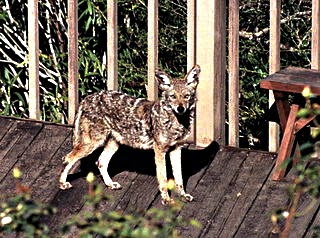Alveolar echinococcosis
 |
| The adult Echinococcus multilocularis tapeworm is very small. The head (or scolex) of this one is to the right. Image: CDC |
This is a nasty parasite and published accounts of the course of the disease in humans are rather horrifying. It spreads and is difficult to treat. It’s often fatal. This one, you never want to get. The literature and the media, meanwhile, lend the distinct impression that E. multilocualris is spreading and cases of alveolar echinococcosis in humans are becoming more common.
Distribution of Echinococcus multilocularis
A map in a 1984 parasitology text showing the global geographic distribution of E. multilocularis suggests that the worm has not broadened its horizons much in the last thirty years. In 1984, its range included most of Asia north of 40º latitude, Central and Eastern Europe, northern Canada, coastal Alaska, and a patch right in the middle of North America bisected by the Canada – US border and by 100º longitude. Today the distribution is marginally wider: more of Central Europe, parts of Western Europe, and the patch in the middle of North America has grown as well. Sporadic cases appear in other far flung regions: northern Africa, British Columbia in Canada.
So E. multilocularis is perhaps creeping rather than sweeping around the northern hemisphere. In truth, human infections are still extremely rare. Alveolar echinococcosisis, however, is “emerging” in humans in European locations, and there’s concern that it might do the same in parts of North America (most North American cases in the past have been in Alaska). In a recent paper in PLOS Neglected Tropical Diseases, Nahorski and others report that, in Poland, only two cases were known prior to 1980, compared with 121 cases diagnosed between 1990 and 2011.
Why is alveolar echinococcosis increasing?
Better diagnosis is certainly one reason for the increase, and Nahorski et al feel that many undiagnosed cases remain. They point to another possible cause however - a boom in the urban fox population. “In Poland,” they write, “the fox population increased from 67 000 in 1995 to 220 000 in 2006.” That’s a very significant increase, and many of the human cases came from provinces where the worm is especially common in foxes. The data led the authors to conclude that infected domestic dogs and cats are also important sources of the disease.
In order for a domestic animal to acquire the intestinal worm, the animal would have to eat an infected rodent. Cats, of course, are hunters, but according to the European Scientific Council Companion Animal Parasites (ESCCAP): “Cats, in contrast to dogs, are epidemiologically insignificant as sources of egg output as they are poor hosts for this worm.” Dogs are a different matter: they are good E. multilocularis hosts, and many domestic dogs do hunt. Many do not of course, especially urban dogs. One would have to know one’s dog to judge the relative likelihood that it would ever have E. multilocularis eggs in its feces, or on its fur.
 |
| Urban coyotes have little fear of people. Image by Steve Jurvetson, Menlo Pk, USA; CC by 2.0 |
So, while there's no reason to be paranoid about this rare disease, awareness of it isn’t a bad thing. All the usual advice still applies: wash your hands often, keep your dog close, and provide your dog with good veterinary care including screening for intestinal parasites.
Resources
Beaver, Paul C., Jung, Rodney C., and Eddie W. Cupp. Clinical Parasitology 9th ed. Philadelphia: Lea & Febiger, 1984. Pg 534.
City of Mississauga. Animal Services: "Foxes." 1995-2013
ESCCAP. “Worm Control in Dogs and Cats: ESCCAP Guideline 01 Second Edition.” September 2010
Nahorski WL, Knap JP, Pawłowski ZS, Krawczyk M, Polański J, et al. "Human Alveolar Echinococcosis in Poland: 1990–2011." PLoS Negl Trop Dis 2013; 7(1): e1986. doi:10.1371/journal.pntd.0001986
Wagner, Holly. “On the Loose: Urban Coyotes Thrive in North American Cities.” Ohio State Research News. Last Updated 2005.

No comments:
Post a Comment